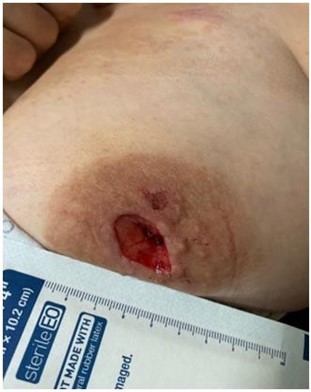International Surgery Case Reports
OPEN ACCESS | Volume 7 - Issue 3 - 2025
ISSN No: 2836-2845 | Journal DOI: 10.61148/2836-2845/ISCR
Rachel Cortese, D.O 1*., Leigh A. Neumayer M.D2
1Department of Surgery Resident, University of Florida College of Medicine-Jacksonville.
2Professor & Chair, Department of Surgery.
*Corresponding author: Rachel Cortese, Department of Surgery Resident, University of Florida College of Medicine- Jacksonville.
Received: April 22, 2025
Accepted: April 28, 2025
Published: April 30, 2025
Citation: Cortese R, Leigh A. Neumayer. (2025) “Case Report: Pyoderma Gangrenosum Resulting in Loss of Nipple.”, International Surgery Case Reports, 7(2); DOI: 10.61148/2836- 2845/ISCR/091
Copyright: © 2025. Rachel Cortese. This is an open access article distributed under the Creative Commons Attribution License, which permits unrestricted use, distribution, and reproduction in any medium, provided the original work is properly cited.
Pyoderma gangrenosum (PG) of the nipple and breast is a rare disease often associated with an underlying systemic condition (1). Common associated rheumatoid arthritis, myelodysplastic syndromes, hepatitis, ankylosing spondylitis, polycythemia vera, and Bechet’s disease, among others. It is generally characterized as a neutrophilic dermatosis related to genetic predisposition in association with a modified inflammatory response (2). Most frequently, the lesions present on the lower extremities (3). PG of the breast is very uncommon, having only 43 reported cases, the majority (70%) of which was in a postoperative state (1). We present a case of de novo unilateral breast PG in a woman with no other known underlying medical conditions and no prior operations involving the breast
Introduction:
Pyoderma gangrenosum (PG) of the nipple and breast is a rare disease often associated with an underlying systemic condition (1). Common associated rheumatoid arthritis, myelodysplastic syndromes, hepatitis, ankylosing spondylitis, polycythemia vera, and Bechet’s disease, among others. It is generally characterized as a neutrophilic dermatosis related to genetic predisposition in association with a modified inflammatory response (2). Most frequently, the lesions present on the lower extremities (3). PG of the breast is very uncommon, having only 43 reported cases, the majority (70%) of which was in a postoperative state (1). We present a case of de novo unilateral breast PG in a woman with no other known underlying medical conditions and no prior operations involving the breast.
Case Presentation:
This is a 40-year-old female with a past medical history of Fragile X syndrome, pyoderma gangrenosum on Remicade who initially presented for a left nipple avulsion. She reports that she has had skin lesions on her legs for approximately the last 12 years. She had previously undergone skin grafting of the left lower extremity wounds which did not heal appropriately resulting in further wounds on her legs. She was diagnosed with pyoderma gangrenosum after a punch biopsy of her left lower extremity. She was started on Remicade which she was prescribed by her rheumatologist. Further testing was remarkable for ANCA IGG and IGA positivity as well as HLA B-27 positive.
She reported that her nipple “fell off” in her sleep. When she presented to the emergency department following this, several sutures were placed and she was placed on a 7-day course of Keflex. When she presented in breast clinic following this, the wound had healed slightly, but there were still portions that were open with minimal sanguineous drainage. She was discharged home with instructions to continue local wound care. Subsequently, she presented back to the emergency department when the nipple had been completely amputated. She had kept the tissue but the decision was made to not attempt to reattach the nipple or to close the wound given poor wound-healing of the other PG lesions on the patient’s skin. The wound care team was consulted who recommended applying Hydrofera blue to the lesion to assist in wound healing.
Discussion:
PG of the breast is a diagnosis of exclusion. It is also often associated with a postoperative state. However, this patient presented with de novo disease without any identifiable underlying conditions. Over 50% of patients have an underlying systemic disease (UpToDate).
In our case, this patient was treated with multiple courses of Keflex with minimal to no improvement of the lesions on her legs or breast. The Remicade, per patient report, did help minimally with limiting the development of new lesions, but it did not help with healing of current lesions.
The patient has not undergone a colonoscopy. The literature on PG indicates that underlying conditions may present after the initial presentation of PG. This patient does not have any other risk factors for colonic disease and would otherwise not undergo colonoscopy until age 45 per current screening recommendations.
Conclusion:
Treatment for PG of the breast is often treated with corticosteroids and debridement (1). Antibiotics can be considered for lesions that have active evidence of infection, but may not make a difference in survivability of the skin, as seen in our patient. This patient was undergoing Remicade treatments every 4-6 weeks under the care of her rheumatology team. For patients with an initial diagnosis of PG without other underlying conditions, screening for other related conditions should be considered. This could include colonoscopy, lab work, and imaging as determined by the provider team.

Figure 1: photo of left breast ofter nipple had completely avulsed.